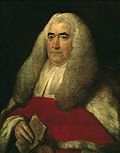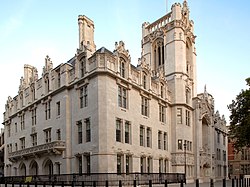English law
English law, also called common law, is the legal system of England and Wales. It is generally divided into criminal law and civil law. It spread to many parts of the former British Empire including Australia, Canada (except Quebec which uses civil law), the United States (except Louisiana which uses civil law) and New Zealand, and many other countries.[1] There are about 80 countries worldwide that use mainly common law systems.[2] About 150 countries use the civil law system.[2]
English law is unique in that it is based on applying legal precedent to present and future decisions made by judges.[1] A judge must follow past legal decisions made by higher courts but not necessarily those made by lower courts.[1] English law is not based on a constitution and there is no codification of laws.[3] However, there are unofficial publications that provide organized lists of current laws.[3] Parliament has the power to create laws which are automatically considered valid and may not be reviewed by the courts.[3] Only Parliament has the power to change a law.[3]
History
Written in about 602, the Law of Æthelberht (Athelbert of Kent) is the oldest example of Anglo-Saxon law,[4] or of law in any Germanic language. Anglo-Saxon law was based on Ancient Germanic law which was a system of laws based on kinship.[5] The kinship group was responsible for the acts of their members as well as for their protection. Wrongs against another were paid by Weregild, a value placed on every person and piece of property.[5] By the 10th century these had changed into a system of hundreds.[5] No longer based on kinship, they organized themselves to protect others in the hundred and to enforce the laws.[5] A hundredsmann was in charge of a hundred and was responsible to see that all disputes were settled.[5]
In 1066, the Norman conquest of England brought with it many changes in the law.[6] While much of Anglo-Saxon law was kept, new laws were added over time by the Normans.[6] Before the Norman invasion, most laws in England were local laws and enforced by local courts.[7] Royal courts were introduced[7] They did not take over local laws right away, but did so over a period of time.[7] The royal courts took the best of the local laws and used them throughout England.[7] This established English common law, or a system of laws common to the entire country.[7] By this time a second court system developed known as equity and administered by the Court of Chancery.[1] Equity addressed situations not covered by common law. Examples of equity decisions include imposing a lien, correcting a property line or ordering someone to do something to prevent damage.[8]
The 18th century legal scholar, William Blackstone, wrote a four-volume Commentaries on the Laws of England which for the first time provided a complete overview of English law.[9] Originally published 1765–1769, it has since been republished many times.[9] Used well into the 19th century, his Commentaries were the main instruction tool in learning the law in both England and America.[9] Abraham Lincoln read Blackstone's Commentaries as part of teaching himself the law.[10]
The jury system
The jury system probably came to England just after the Norman conquest.[11] At first, jurors acted as witnesses in court. But over time, certainly by the reign of Henry II of England, they became the trier of fact in a court case.[11] Juries began to deliberate the evidence provided by the parties in a dispute. Over time, jurors were told less and less about a case before a trial and learned what they needed to make a decision in court.[11]
Application to Wales
Unlike Scotland and Northern Ireland, Wales is not a separate jurisdiction in the United Kingdom. The old laws of Wales within the Kingdom of England were abolished by King Henry VIII's Laws in Wales Acts. This brought Wales into legal conformity with England. Between 1746 and 1967, any reference to England in legislation included Wales. This ceased with the enactment of the Welsh Language Act 1967. The jurisdiction is now commonly referred to as "England and Wales". Although Wales has a degree of political autonomy, it did not have the ability to pass primary legislation until the Government of Wales Act 2006 came into force after the 2007 Welsh general election. Even so, the Welsh legal system remains English common law. This is different from the situation of Northern Ireland. It did not stop being a distinct jurisdiction when its legislature was suspended. A major difference is also the use of the Welsh language, as laws concerning it apply in Wales and not in the rest of the United Kingdom. The Welsh Language Act 1993 is an Act of the Parliament of the United Kingdom. It put the Welsh language on an equal footing with the English language in Wales with regard to the public sector. Welsh may also be spoken in Welsh courts.
Sources of English law
In England, there is a hierarchy of sources, as follows:
- European Union law (a primacy challenged by Britain's Brexit)
- Legislation (primary and secondary)
- The case law rules of common law and equity, derived from precedent decisions
- Parliamentary conventions
- General customs
- Books of authority
English Law Media
The Royal Courts of Justice is on the Strand in London. Together with its adjacent Thomas More Building and its outpost Rolls Building on Fetter Lane, it is the main seat of the High Court of Justice and the ordinary seat of the Court of Appeal.
Statue of Lady Justice on the dome of the Central Criminal Court of England and Wales in the City of London (the "Old Bailey")
Sir William Blackstone in 1774, after his appointment as a Justice of the Court of King's Bench
A map of the British Empire under Queen Victoria at the end of the nineteenth century. "Dominions" refers to all territories belonging to the Crown.
The former Middlesex Guildhall in Parliament Square is now the location of the Supreme Court of the United Kingdom.
Related pages
References
- ↑ 1.0 1.1 1.2 1.3 "English Law: An introduction". In Brief. Retrieved 6 October 2016.
- ↑ 2.0 2.1 Piyali Syam (28 January 2014). "What is the Difference Between Common Law and Civil Law?". Washington University School of Law. Retrieved 18 February 2016.
- ↑ 3.0 3.1 3.2 3.3 "English Law". Duke Law School. Retrieved 6 October 2016.
- ↑ Percy Henry Winfield 2000. The chief sources of English legal history. Washington DC: Beard Books, p44.
- ↑ 5.0 5.1 5.2 5.3 5.4 David Robison. "The De-Evolution of Anglo-Saxon Law". Practical Law and Justice. Archived from the original on 18 March 2016. Retrieved 6 October 2016.
- ↑ 6.0 6.1 Robert Wilde. "The Consequences of the Norman Conquest". About Education. About, Inc. Archived from the original on 5 December 2016. Retrieved 6 October 2016.
- ↑ 7.0 7.1 7.2 7.3 7.4 "Equity Lecture Notes, Historical Introduction". LawTeacher. All Answers Ltd. Archived from the original on 14 October 2016. Retrieved 6 October 2016.
- ↑ "equity". Law.com/ALM. Retrieved 6 October 2016.
- ↑ 9.0 9.1 9.2 "Sir William Blackstone, 1723 - 1780". Online Library of Liberty. Liberty Fund, Inc. Retrieved 6 October 2016.
- ↑ "The Commentaries on the Laws of England". The Law Library of Queens County, 11th Judicial District, Supreme Court. New York State Unified Court System. Archived from the original on 2 June 2010. Retrieved 6 October 2016.
- ↑ 11.0 11.1 11.2 "The Jury System". LawTeacher. All Answers Ltd. Retrieved 6 October 2016.






